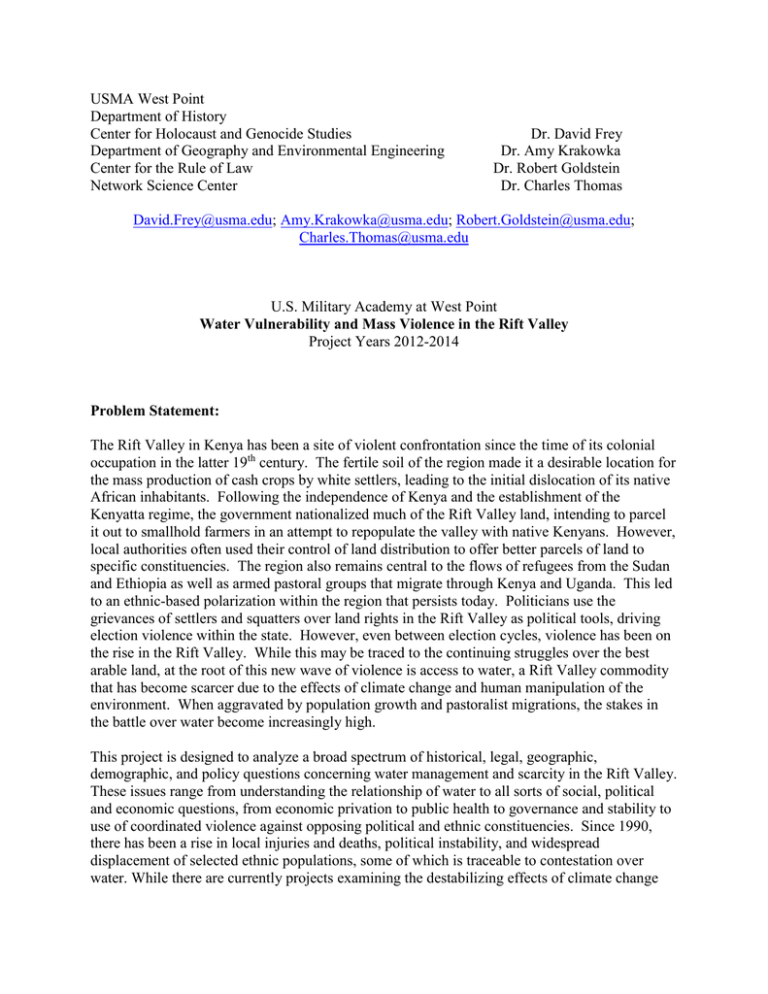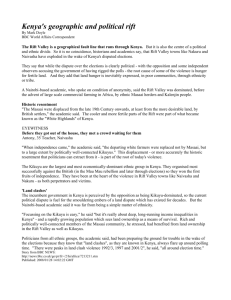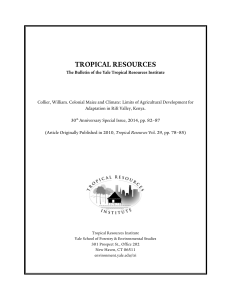USMA WVMV problem statement
advertisement

USMA West Point Department of History Center for Holocaust and Genocide Studies Department of Geography and Environmental Engineering Center for the Rule of Law Network Science Center Dr. David Frey Dr. Amy Krakowka Dr. Robert Goldstein Dr. Charles Thomas David.Frey@usma.edu; Amy.Krakowka@usma.edu; Robert.Goldstein@usma.edu; Charles.Thomas@usma.edu U.S. Military Academy at West Point Water Vulnerability and Mass Violence in the Rift Valley Project Years 2012-2014 Problem Statement: The Rift Valley in Kenya has been a site of violent confrontation since the time of its colonial occupation in the latter 19th century. The fertile soil of the region made it a desirable location for the mass production of cash crops by white settlers, leading to the initial dislocation of its native African inhabitants. Following the independence of Kenya and the establishment of the Kenyatta regime, the government nationalized much of the Rift Valley land, intending to parcel it out to smallhold farmers in an attempt to repopulate the valley with native Kenyans. However, local authorities often used their control of land distribution to offer better parcels of land to specific constituencies. The region also remains central to the flows of refugees from the Sudan and Ethiopia as well as armed pastoral groups that migrate through Kenya and Uganda. This led to an ethnic-based polarization within the region that persists today. Politicians use the grievances of settlers and squatters over land rights in the Rift Valley as political tools, driving election violence within the state. However, even between election cycles, violence has been on the rise in the Rift Valley. While this may be traced to the continuing struggles over the best arable land, at the root of this new wave of violence is access to water, a Rift Valley commodity that has become scarcer due to the effects of climate change and human manipulation of the environment. When aggravated by population growth and pastoralist migrations, the stakes in the battle over water become increasingly high. This project is designed to analyze a broad spectrum of historical, legal, geographic, demographic, and policy questions concerning water management and scarcity in the Rift Valley. These issues range from understanding the relationship of water to all sorts of social, political and economic questions, from economic privation to public health to governance and stability to use of coordinated violence against opposing political and ethnic constituencies. Since 1990, there has been a rise in local injuries and deaths, political instability, and widespread displacement of selected ethnic populations, some of which is traceable to contestation over water. While there are currently projects examining the destabilizing effects of climate change and resource management in the region, most notably the Minerva Initiative-funded Climate Change and African Political Stability (CCAPS) project based at the University of Texas and the Centre for Development Research in Copenhagen’s project on “Customs and Conflict in Land and Water Management in Africa”, even these are broad and regional in nature. Few studies focus on the issues of water access, ownership, scarcity, and human security specifically in the upper Rift Valley region. As such, the Water Vulnerability and Mass Violence (WVMV) project will set out to answer a series of questions involved in the Rift Valley. What direct effects does decreasing water supply have in the region? How have humans historically manipulated water scarcity in the region, and how has human action exacerbated or alleviated water scarcity? What are the geological, topographical, and ecological reasons for water scarcity, and how can we accurately predict future water choke points or locate new aquifers? What are the legal implications of crossborder water regulation and distribution, scarcity-induced migration/refugeeism, and scarcityinduced instability? What are the demographic and health related problems tied to water scarcity? What forms do water-access disputes take, which networks of people most benefit and which are most victimized? What legal tools and environmental technologies exist which might mitigate water-access violence? Which populations are the aggressors and which are most at risk in current and future water scarcity-related violence, and how is ethnicity bound up in resource scarcity violence? What political and transnational structures and problems of governance exist that help or hinder efforts to provide security for the region? These questions are central to the continued efforts at stabilizing this region and the understanding of the dynamics of water scarcity. The WVMV findings have the potential to influence the United States’ military’s efforts at stabilizing other water-starved regions, and to help prevent future atrocities.







